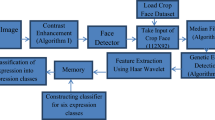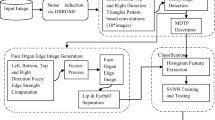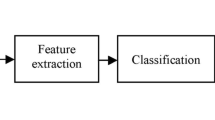Abstract
Facial expression detection (FED) and extraction show the most important role in face recognition. This research proposed a new algorithm for automatic live FED using radial basis function; Haar discrete wavelet transform and Gray-level difference method is used for feature extraction and classification. Detect edges of the facial image by Otsu algorithm. The implementation results worked on Japanese Female Facial Expressions and Cohn–Kanade Extended (CK+) database for facial expression. The other database used for face detection process, namely, CMU, BioID, Long Distance, and FEI. It is usually possible for practical recognition system to record (by a camera or by computer) multiple face images from each subject. Choosing face images with high tone for recognition is a promising strategy for improving the system performance. We propose a learning to rank based (solid basic structure on which bigger things can be built) for evaluating the face image quality. But we improved limitations of this algorithm using contrast enhancement. We solved the problem of long distance and low contrast images. In the initial preprocess stage; perform median filtering for removing noise from an image. This step enhances the feature extraction process. Finding an image from the image components is a typical task in pattern recognition. The detection rate has reached up to 100% for expression recognition. The proposed system estimates the value of precision and recall. This algorithm is compared with the previous algorithm and our proposed proved better than previous algorithms.






















Similar content being viewed by others
References
Talele, K., Kadam, S., & Tikare, A. (2012). Efficient face detection using Adaboost. In IJCA proceedings of international conference on computational intelligence, 2012.
Mita, T., Kaneko, T., & Hori, O. (2005). Joint Haar-like features for face detection. In Tenth IEEE international conference on computer vision (ICCV’05) (Vol. 2, pp. 1619–1626). IEEE, 2005.
Ahonen, T., Hadid, A., & Pietikainen, M. (2004). Posters i-face recognition with local binary patterns. Lecture Notes in Computer Science, 3021, 469–481.
Abdelwahab, M. M., Aly, S. A., & Yousry, I. (2012). Efficient web-based facial recognition system employing 2DHOG. arXiv preprint arXiv:1202.2449.
Turk, M. A. & Pentland, A. P. (1991). Face recognition using eigenfaces. In IEEE computer society conference on computer vision and pattern recognition, 1991. Proceedings CVPR’91 (pp. 586–591). IEEE, 1991.
Lu, J., Plataniotis, K. N., & Venetsanopoulos, A. N. (2003). Face recognition using LDA-based algorithms. IEEE Transactions on Neural Networks, 14(1), 195–200.
Wiskott, L., Fellous, J.-M., Kuiger, N., & Von Der Malsburg, C. (1997). Face recognition by elastic bunch graph matching. IEEE Transactions on Pattern Analysis and Machine Intelligence, 19(7), 775–779.
Garcia, C., & Delakis, M. (2004). Convolutional face finder: A neural architecture for fast and robust face detection. IEEE Transactions on Pattern Analysis and Machine Intelligence, 26(11), 1408–1423.
Yang, M.-H., Kriegman, D. J., & Ahuja, N. (2002). Detecting faces in images: A survey. IEEE Transactions on Pattern Analysis and Machine Intelligence, 24(1), 34–58.
Happy, S. L., & Routray, A. (2013). Automatic facial expression recognition using features of salient facial patches. IEEE Transactions on Affective Computing. https://doi.org/10.1109/TAFFC.2014.2386334.
Song, M., Tao, D., Liu, Z., Li, X., & Zhou, M. (2010). Image ratio features for facial expression recognition application. IEEE Transactions on Systems, Man, and Cybernetics. Part B, Cybernetics, 40(3), 779–788.
Luo, Y., Wu, C. M., & Zhang, Y. (2013). Facial expression feature extraction using hybrid PCA and LBP. The Journal of China Universities of Posts and Telecommunications, 20(2), 120–124.
Luo, Y., Wu, C. M., & Zhang, Y. (2013). Facial expression recognition based on fusion feature of PCA and LBP with SVM. Optik, 124, 2767–2770. https://doi.org/10.1016/j.ijleo.2012.08.040.
Naveen, S., & Moni, R. S. (2015). A robust novel method for face recognition from 2D Depth Images using DWT and DCT Fusion. Procedia Computer Science, 46, 1518–1528.
Muqeet, M. A., & Holambe, R. S. (2017). Local appearance-based face recognition using adaptive directional wavelet transform. In Proceedings of journal of King Saud University—Computer and information sciences (2017).
Shen, X., Lin, Z., Brandt, J., & Wu, Y. (2013). Detecting and aligning faces by image retrieval. In Proceedings of IEEE conference on computer vision and pattern recognition (pp. 3460–3467).
Leibe, B., Leonardis, A., & Schiele, B. (2006). An implicit shape model for combined object categorization and segmentation. In Proceedings of European conference on computer vision workshop on statistical learning in computer vision (pp. 508–524).
Smith, B., Brandt, J., Lin, Z., & Zhang, L. (2014). Nonparametric context modeling of local appearance for pose- and expression robust facial landmark localization. In Proceedings of IEEE conference on computer vision and pattern recognition (pp. 1741–1748).
Belhumeur, P., Jacobs, D., Kriegman, D., & Kumar, N. (2013). Localizing parts of faces using a consensus of exemplars. In Proceedings of IEEE conference on computer vision and pattern recognition (pp. 545–552).
Dantone, M., Gall, J., Fanelli, G., & van Gool, L. (2012). Real-time facial feature detection using conditional regression forests. In Proceedings of IEEE conference on computer vision and pattern recognition (pp. 2578–2585).
Yang, H., & Patras, I. (2012). Face parts localization using structured output regression forests. In Proceedings of asian conference on computer vision (pp. 667–679).
Vo, D. M., & Le, T. H. (2016). Deep generic features and SVM for facial expression recognition. In Proceedings of IEEE conference on information and computer science (pp. 80–84).
Kotsia, I., & Pitas, I. (2007). Facial expression recognition in image sequences using geometric deformation features and support vector machines. IEEE Transactions on Image Processing, 16(1), 172–187.
Saad, I. A., George, L. E., & Tayyar, A. A. (2014). Accurate and fast pupil localization using contrast stretching, seed filling and circulargeometrical constraints. Journal Of Computer Science, 10(2), 305–315.
Lyons, M. J., Kamachi, M., & Gyoba, J. (1997). Japanese female facial expressions (JAFFE), Database of digital images, 1997.
Face detection: http://www.mathworks.com/matlabcentral/fileexchange/20976. Accessed May 2017.
Kumar, S., Singh, S., & Kumar, J. (2017). Automatic face detection using genetic algorithm for various challenges. International Journal of Scientific Research and Modern Education, 2(1), 197–203.
Otsu, N. (1979). A threshold selection method from gray-level histograms. IEEE Transactions on Systems, Man, and Cybernetics, 9(1), 62–66.
Xu, X.-Y., Song, E.-M., & Jin, L.-H. (2007). Characteristic analysis of threshold based on otsu criterion. Acta Electronica Sinica, 33(14), 188–189.
Huang, M., Yu, W., & Zhu, D. (2012). An improved image segmentation algorithm based on the otsu method. In 13th ACIS international conference on software engineering, artificial intelligence, networking, and parallel/distributed computing, 2012. IEEE.
Li, J., Yan, X., & Zhang, D. (2010). Optical braille recognition with haar wavelet features and support-vector machines. In IEEE international conference on, computer, mechatronics, control and electronic engineering (CMCE) (Vol. 5, pp. 64–67). IEEE.
Lu, H., & Zheng, Z. (2010). Two novel real-time local visual features for omnidirectional vision. Pattern Recognition, 43(12), 3938–3949.
Jog, N. V., & Mahadik, S. R. (2014). Implementation of classification technique for mammogram image. IOSR Journal of Electronics and Communication Engineering (IOSR-JECE), 9(1), 76–78.
Jee, H., Lee, K., & Pan, S. (2004). Eye and face detection using SVM. In IEEE proceedings of intelligent sensors, sensor networks and information processing conference (pp. 577–580).
Lucey, P., Cohn, J. F., Kanade, T., Saragih, J., Ambadar, Z., & Matthews, I. (2010). The extended Cohn–Kande dataset (CK+): A complete facial expression dataset for action unit and emotion-specified expression. In 3rd IEEE workshop on CVPR for human communicative behavior analysis, 2010.
Author information
Authors and Affiliations
Corresponding author
Additional information
Publisher's Note
Springer Nature remains neutral with regard to jurisdictional claims in published maps and institutional affiliations.
Rights and permissions
About this article
Cite this article
Kumar, S., Singh, S. & Kumar, J. Live Detection of Face Using Machine Learning with Multi-feature Method. Wireless Pers Commun 103, 2353–2375 (2018). https://doi.org/10.1007/s11277-018-5913-0
Published:
Issue Date:
DOI: https://doi.org/10.1007/s11277-018-5913-0




